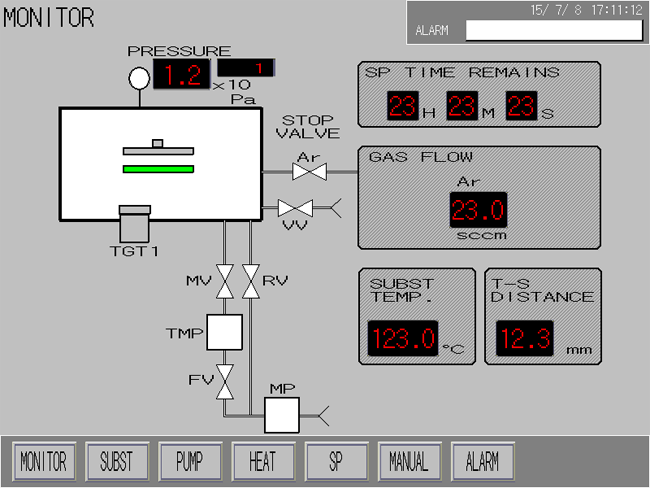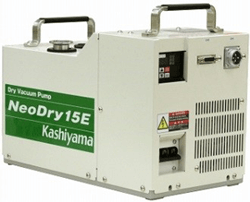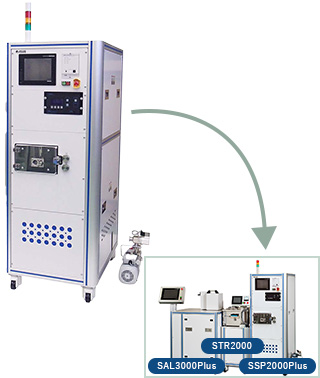Sputtering Equipment (Expandable type)Sputtering equipment is a PVD-type thin film forming equipment that utilizes the sputtering phenomenon in which ionized Ar gas under plasma discharge collides with a target at high speed, and target atoms ejected by the collision are deposited on the substrate.
SSP2000Plus
Dual-cathode slim tower
It can be combined with ALD and/or anneal equipment
POINT
- Dual-cathode single tower
- It can be combined with other Plus series equipment.
- User friendly middle class model
Outer dimension (Main unit)
W608mm×D800mm×H1827mm
| Cathode | Uniformity | Substrate heater | Combination |
|---|---|---|---|
| 2 pieces | ≦±5%(Substrate rotation) | 300℃ | ✔ |
Outline・Application
It plays an active role in R&D applications such as metal films, insulating films, conductive films, protective films, reflective films, catalysts, coatings, circuits, batteries, MEMS and new advanced material.
It’s considered as the high end model since it has a MAX300℃ substrate heating mechanism whereas SSP1000 does not have such a mechanism.
Feature
【Feature1】Dual-cathode
Equipped with two φ2 inch magnetron cathodes (with shutters), and a film thickness distribution within ± 5% up to φ100mm can be performed. By switching the cathode to be discharged, this equipment can also form stacked layers.

<!–
真空チャンバー内

–>
【Feature2】Max 300℃ Substrate Heating Mechanism
MAX300℃ heater is included as the standard and makes it possible to obtain high quality film formation due to its substrate heating function.
* SSP3000Plus and SSP3000 can apply the heat on the substrate up to MAX800℃ as an option.
【Feature3】RF power supply (With pulse mode)
Stable film formation can be obtained even for insulating material targets which can cause abnormal discharge due to the high-frequency RF power supply with a pulse oscillation function.

【Feature4】Expandability
The function of a load lock chamber can be added by connecting with the transfer unit STR2000 through the port which is provided on the side of the main unit. In addition, deposition without exposing the substrate to the atmosphere can be possible by combining with Plus series of sputtering equipment, ALD equipment, annealing equipment, and vapor deposition equipment.

Combination with SAL3000Plus ALD
【Feature5】Easy operation by touch screen
It employs GUI (Graphical User Interface) for its program which allows the operator to work intuitively and has visibility to check various statuses including operating conditions, and operability to make an easy adjustment for valves and setting items.
During the process, the status of the device can be easily observed on the status screen.
In addition, it is a touch screen program that combines operability and safety with various interlocks and alarm functions.
It is designed under the assumption that modification will be needed to meet the requirement which can be changed on a daily basis to be capable for such modifications so the cost for changing the program can be relatively low.

Monitor display * This monitor displays one cathode type. Standard has two cathodes.
【Feature6】Space saving slim tower design
A slim tower shape design, 608 mm(W) x 800 mm(D), is employed that combines the deposition chamber, exhaust system and control system all into one.
Compared to a device with a separate main body and control stand, it has a clean appearance with no extra wiring exposed on the back of the device. It can be easily moved during relocation work or indoor layout changes after the installation and it can reduce such work volume and cost.
SSP2000Plus Specification

SSP2000Plus Outer dimension

OPTION
Various options are available.
1.Deposition of magnetic materials
In case of film deposition with magnetic materials such as iron (Fe), a stable plasma discharge cannot be obtained by the standard magnetron cathode.
Therefore, it is possible to select the specifications of the cathode for magnetic materials. Even after the installation, both magnetic and non-magnetic materials can be used by parts replacement.
2.Deposition of thin targets
The dimension of cathode is φ50.8mm x t3mm as the standard. For the demand to minimize the cost for the target to be 3mm thick or for the less frequent film deposition, shield and target holder for thin targets such as 1 mm and 2 mm is available.
* Depending on the material, thin targets may be difficult to be discharged.
* Abnormal discharge may occur in the extra space between the target and the shield when thin target is sputtered in combination with standard 3mm thick parts and film deposition may not be established.
3.Additional process gas introduction
Max. 2 process gas introduction systems can be equipped with.
The reactive sputtering to introduce oxygen or nitrogen requires this addition.
4.Replaced to dry pump
The subsidiary pump can be replaced from rotary pump to dry pump. Basically, a dry pump is required in a clean room. Our non-contact multi-stage roots type dry pump can offer maintenance-free clean vacuum condition over a long period of time.

TECHNOLOGY
SUGA’s Sputtering Equipment
Sputtering equipment is a film-forming equipment that uses sputtering method, which is classified as physical vapor deposition (PVD) within the category of vacuum thin film formation. Thin films obtained by sputtering equipment have excellent adhesion to substrates, high reproducibility during repeated film formation, and the ability to produce high melting point materials and alloys. It is also possible to produce oxide and nitride films as well as metal films and insulating films that are indispensable for functional materials such as semiconductors and electronic devices.
SUGA Co., Ltd. has applied technology and strict quality standards that has been accumulated over many years as a partner company of a major vacuum equipment manufacturer to its own brand equipment which makes it possible to design and manufacture user-friendly, robust, high quality sputtering equipment to meet the customer’s needs.
Feature of sputtering
• Since the impact energy of the material that collides with the substrate is strong, a thin film with high adhesion can be obtained.
• Since the material flies linearly in a certain direction, the film adheres less to other than the substrate compared to the conventional deposition methods. However, a film is difficult to adhere to the side wall surface of the uneven portion.
• Film thickness can be easily controlled by adjusting various conditions such as power supply and deposition time.
• A film with a uniform thickness can be formed over a wide area.
• High melting point materials and insulating films can be formed.
• When making an alloy, the composition of the material is less likely to be changed compared to a vapor deposition that melts the material at a high temperature.
• Compound film also can be obtained by reactive sputtering combining nitrogen, oxygen, hydrogen, etc.
• Deposition surface of the substrate can be plasma cleaned (reverse sputtering) by applying high pressure to the substrate holder.
• The deposition speed (deposition rate) is slower than the vapor deposition.
The structure and principle of the sputtering equipment

01.Vacuum chamber
The cathode (electrode) for mounting the target material and the substrate (wafer) are placed to be opposite in the vacuum chamber. The distance between them is about several tens to hundred mm.
The figure shows an example of sputter up (face down) in which the deposition direction is from bottom to top. The sputter-up arrangement has two advantages: it prevents foreign material to adhere to the substrate surface, and the cathode side with a water cooling mechanism is easy to maintain.
Sputter down (face up) arrangement with the mechanism turned upside down is useful for film deposition that cannot be fixed.
A sliding shutter plate is placed between the cathode and the substrate so that the film formation timing can be controlled.
02.Cathode
SUGA Co., Ltd. employs PMC (Planar Magnetron Cathode) system. The green dotted line in the figure explains collectively called the cathode.
An oxygen-free copper back plate (backing plate) is placed on the back of the sputtering target, which is the film forming material. Although many metal-based targets can be deposited properly when it’s placed on a backing plate, compound targets are often required “bonding process” to bond to the backing plate in order to increase cooling efficiency and prevent cracking and breakage of the material.
Whole series of services are available from target arrangement to bonding processing.
A water-cooled permanent magnet is placed under the back plate. A ring-shaped magnet and a cylindrical magnet are fixed to the base of the disk (Yoke) although the figure appeared to be showed that three magnets are arranged. A circular tunnel is formed on the target where the magnetic field generated by the magnet and the electric field generated by the application of voltage are orthogonal to each other, and a high-density plasma discharge is generated in this area.
03.Vacuum, and Ar gas
To generate plasma discharge, first evacuate the vacuum vessel (film formation chamber). In general, 0.2~10Pa is good enough for plasma discharge but for the purpose of producing high-quality thin films, it is desirable to reduce the gas components (outgas) released from the inner walls and structures of the equipment under vacuum as well as residual gas typified by water present in the deposition chamber as much as possible
Therefore, a turbo molecular pump is employed that can reduce pressure to the high vacuum range. Depending on the specifications of the equipment and pump, a certain amount of time will be required to obtain 10-5 Pa or even lower.
After reducing the pressure to the ultimate vacuum, keep the pressure at about 0.5Pa after plasma excitation while introducing a high-purity argon gas.
The reason why argon gas is used in the sputtering equipment is that the sputtering rate is relatively good and the inert gas should make it difficult for chemical reactions with other materials to occur. Argon is also popular because of its high purity and low costs.
N2 and O2 may be used for reactive sputtering other than argon. Rare gases such as He, Ne, Kr, and Xe may be used for other purposes.
04.Plasma discharge
By RF sputtering power supply, voltage is applied to the cathode and electrons emitted from the target surface collide with floating argon molecules. Electrons are knocked out of the argon molecules by collision and Ar + ions are generated. Electrons have the property of flowing into the conductive body, but there is no escape near the target under the plasma. As a result, the density of plasma increases near the magnetic field above the target, and Ar + ions are generated efficiently.
Ar + ions, which are accelerated by an electric field under plasma, fly and collide at high speed (thousands of kilometers per second) toward the cathode surface. The phenomenon that Ar + ions blow off target atoms is called sputtering.
The atoms on the cathode surface are sputtered by collision with Ar ions, and collide at high speed (10,000 km per hour) at the opposite substrate side. A thin film is gradually formed on the surface of the substrate due to repeated collisions of atoms of the target material. Since atoms collide with strong kinetic energy on the substrate surface, the thin film formed by sputtering equipment has excellent adhesion.
05.RF power supply
As the standard, SUGA Co., Ltd. employs RF power supply for its Sputtering equipment. RF sputter is equipped with a 13.56MHz high frequency AC power supply (RF power supply) and matched in the matching box, and discharged while switching the anode and cathode at high speed.
For insulating target material, discharge does not last in DC power sourced sputtering equipment whereas RF power sourced sputtering equipment can stably maintain plasma and has better flexibility. In addition, since an RF power supply with a pulse function is adopted as standard, insulation targets that are prone to abnormal discharge can be also handled.
Please get the local consultation for the installation of high frequency wave equipment.
Send us an inquiry if you have any questions.

